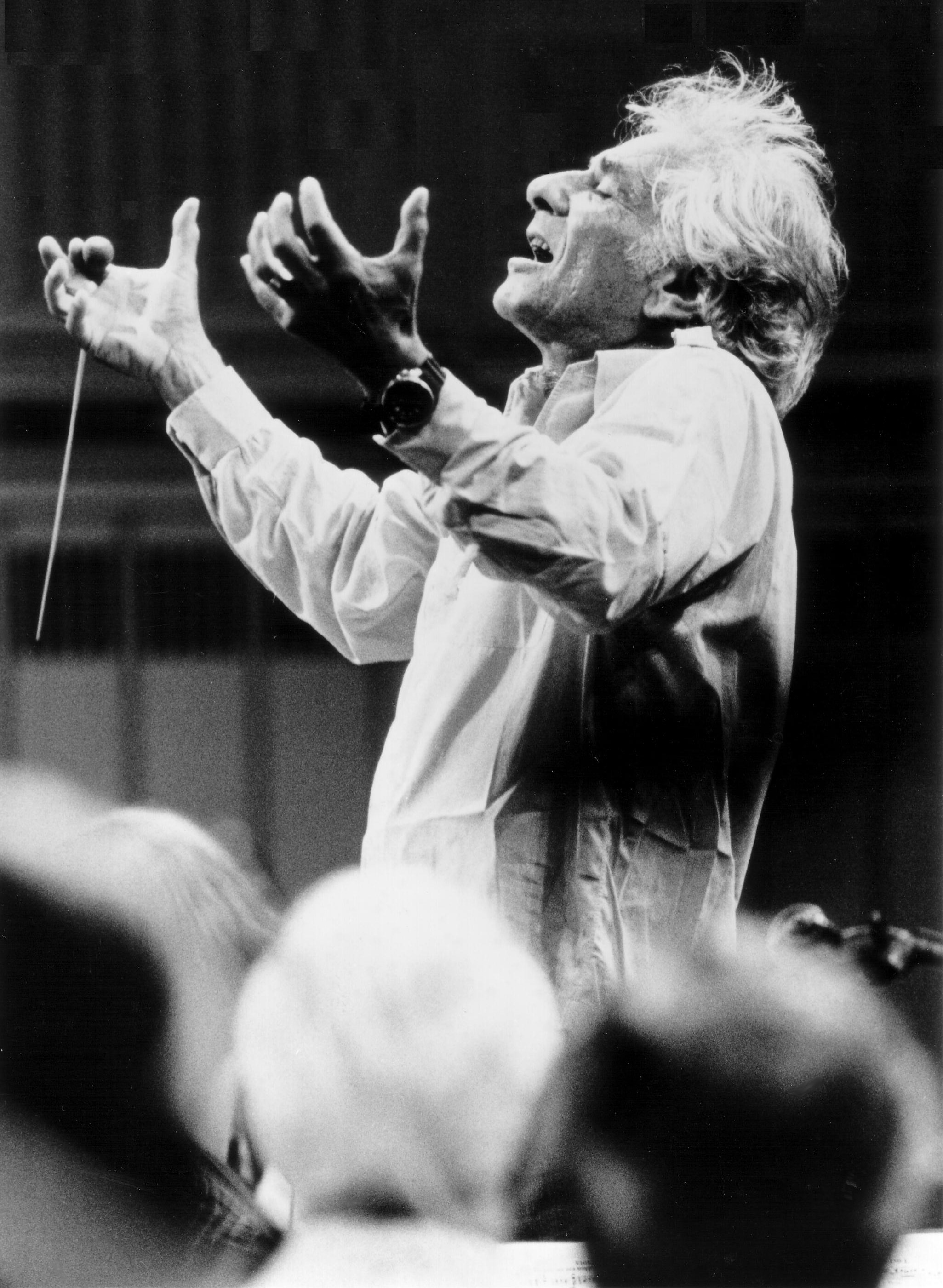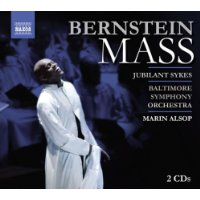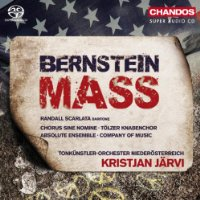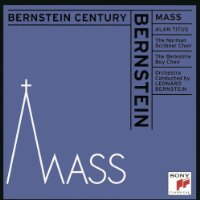I’m Listening to Everything Composed by Bernstein
August 25, 2013 Last week, the piece I investigated was so short, I thought I’d better go big this week! Leonard Bernstein’s Mass is the subject of today’s blog entry and it’s almost two hours long. So, yeah, long… And we’re also celebrating a birthday today. On this day 95 years ago, Leonard Bernstein was born. (He died in 1990) Most people know him as the composer of “West Side Story” and that is certainly what he is most famous for. But it shouldn’t be! He wrote so many wonderful pieces—vocal solos, chamber music, symphonies, concerti, etc.—it seems a shame to only focus on his musical theatre pieces. So…here we go…
Last week, the piece I investigated was so short, I thought I’d better go big this week! Leonard Bernstein’s Mass is the subject of today’s blog entry and it’s almost two hours long. So, yeah, long… And we’re also celebrating a birthday today. On this day 95 years ago, Leonard Bernstein was born. (He died in 1990) Most people know him as the composer of “West Side Story” and that is certainly what he is most famous for. But it shouldn’t be! He wrote so many wonderful pieces—vocal solos, chamber music, symphonies, concerti, etc.—it seems a shame to only focus on his musical theatre pieces. So…here we go…
TITLE: Mass
DESCRIPTION OF THE PIECE: Leonard Bernstein was a non-practicing Jew who wrote a Catholic Mass. It was composed as a protest against the Vietnam War. It questions authority and assumptions of belief. It challenges all who listen to reconsider the way they’re leading their lives and the way the country is heading (was heading in the 1970’s). It is rarely performed today in its entirety because of the score’s demands. In order to perform the Mass as Bernstein intended, you need to have a male singer, the “Celebrant” (a Catholic priest), a boys choir, a traditional choir, opera singers, jazz singers, rock singers, a full symphony orchestra, a marching band, a rock band, and an elaborate sound system, not to mention a roomy venue. Here are brief descriptions of each section of the Mass. (These descriptions are most effective if you listen to the Mass as you go.)
1. Devotions before Mass: Antiphon: Kyrie eleison The traditional Greek text for the Kyrie is presented here in continually more dissonant imitative polyphony.
2. Devotions before Mass: Hymn and Psalm, “A Simple Song” English text, sung by the Celebrant. Strong influence of 70’s pop music (chords, rhythms, etc.)
3. Devotions before Mass: Responsory, “Alleluia” Vocal jazz-ish choir complete with nonsense syllables and, of course, “alleluia”
4. First Introit: Prefatory Prayers Marching band style with traditional choir, later joined by boys choir and, eventually, kazoo choir—yep.
5. First Introit: Thrice-Triple Canon: Dominus vobiscum As the title implies it’s a three-part round. Simple and short.
6. Second Introit: In nomine Patris Features eastern rhythms and instruments.
7. Second Introit: Prayer for the Congregation, “Almighty Father” SATB hymn—very pretty.
8. Second Introit: Epiphany Oboe played through various speakers throughout the venue—stereophonic sound all over the place.
9. Confession: Confiteor Starts out dissonant and choral, evolves into a jazzy blues sound as the choir asks for forgiveness.
10. Confession: Trope, “I Don’t Know” Another 70’s rock song.
11. Confession: Trope, “Easy” A bluesy jazz song. Eventually the previous two numbers return in this number.
12. Meditation No. 1 Maybe it’s simply because I know Bernstein was Jewish, but this really sounds similar to his Symphony #1 “Jeremiah” which is based on the Hebrew Old Testament Lamentations of Jeremiah.
13. Gloria: Gloria tibi One of my favorite sections. Bass solo with boys choir.
14. Gloria: Gloria in Excelsis Probably my favorite choral piece in the entire Mass. I love his purposeful skewing of scansion (syllables being accented when they’re not supposed to be). Plus there’s a jazzy element to this that seems so out of place with the liturgical text.
15. Gloria: Trope, “Half of the People” This is really just a continuation of the Gloria but with English words (penned by Paul Simon no less).
16. Gloria: Trope, “Thank You” Slow, peaceful, female solo.
17. Meditation No. 2 Again, I’m hearing Symphony #1, but hey, it’s awesome.
18. Epistle: “The Word of the Lord” Some dramatic narrations interspersed with some pop-sounding solo and choral singing.
19. Gospel-Sermon: “God Said” This may offend some listeners because there’s some taking of the Lord’s name in vain. I think Bernstein chose to use the particular phrase because it is (sadly) part of our collective vernacular and because it is shocking when used in the context of a Mass.
20. Credo: Credo in unum Deum A highly rhythmic percussive re-imagining of plainchant?
21. Credo: Trope, “Non Credo” The Celebrant doubts the creed and questions God. I suspect Catholics would find this offensive? And possibly other Christians? Well, I’m a Christian and I’m not offended. I simply recognize that Bernstein was protesting authority and this was one of the ways he could depict/convey that.
22. Credo: Trope, “Hurry” – Sedet ad dexteram Patris Female solo prayer/demand followed by some more of the plainchant style of the Credo in unum Deum.
23. Credo: Trope, “World without End” – Et in Spiritum Sanctum Musical theatre-type song for female solo.
24. Credo: Trope, “I Believe in God” Another questioning of God’s existence. Again, I hope my readers will not be offended by this. Please listen to it in the context of what Bernstein was protesting. (Plus, there’s some funny music-related jokes near the end.)
25. Meditation No. 3 This time with choir!
26. Offertory Reprises “In Nomine Patris (#6)”
27. The Lord’s Prayer: Our Father … Unaccompanied version of the Lord’s Prayer, sung by the Celebrant.
28. The Lord’s Prayer: Trope, “I Go On” The Celebrant is sad and confused about the way the world is, but is determined to go on and praises God in the process.
29. Sanctus Another of my favorite sections—tuneful, pleasant, peppy, but melancholy and wistful at times, angry at other times. Uses Hebrew text at times as well.
30. Agnus Dei Not your normal Agnus Dei—usually the words “Dona nobis pacem (give us peace)” are set to quiet and peaceful music. Here (again, remember the context) they’re angry and demanding. Also a little beyond the halfway mark in this section, a heavy blues kicks in, the text changes to English, various jazz and rock instruments join in and it gets more and more cacaphonic through to the end.
31. Fraction: “Things Get Broken” The Celebrant has a nervous breakdown—accusing, demanding, turning away from God.
32. Pax: Communion, “Secret Songs” A boy soprano reprises the “simple song” from the beginning and seems to restore everyone, including the Celebrant’s, faith. The hymn from earlier (“Almighty Father” [#7]) returns sung by all the singers AND the instrumentalists.
HIGHLIGHT: It’s hard to pick a highlight simply because it works so well as a single work of art. But I really enjoy the Agnus Dei (#30) and the “Simple Song” (#2). There are some really interesting recordings out there of this work. For most of my adult life I’ve only been familiar with the original recording (1971) And it is fantastic! But in writing this entry, I’ve discovered a few more recordings that are quite awesome in their own ways. One is by the Baltimore Symphony with Jubilant Sykes in the lead role (as the Celebrant).  This recording sounds like they acquired REAL jazz and blues singers. It’s got a grittiness that is marvelous to hear. The third recording that I found was recorded in Austria.
This recording sounds like they acquired REAL jazz and blues singers. It’s got a grittiness that is marvelous to hear. The third recording that I found was recorded in Austria.  It’s a tad odd/fun to hear German singers trying to get the English pronunciations correct, and also trying to get the jazz/blues sound correct. The female jazz singer is the most successful, but still an unusual effect.
It’s a tad odd/fun to hear German singers trying to get the English pronunciations correct, and also trying to get the jazz/blues sound correct. The female jazz singer is the most successful, but still an unusual effect.
WHAT’S LEFT TO LISTEN TO BY BERNSTEIN?: Approximately 70 more compositions. Not insurmountable. I’ll do it!
